I had the day to myself today so I headed to the forest, free to study plants and whatever else might take my fancy, without risk of annoying anyone else. My aim was to forage mushrooms and practice some navigation techniques.
The day started overcast and cool and had a particularly peaceful feel to it. I wandered through a mixture of Scots pine, larch, beech and oak. I was pleased to see plenty of acorns this year. Initially it seemed I was a little early for mushrooms, despite the recent rains.
But eventually I came across the following. It had pores on the underside - so some kind of bolette - and stained purple when cut. It had a malevolent look to it. Beyond that, I'm not sure what it is.
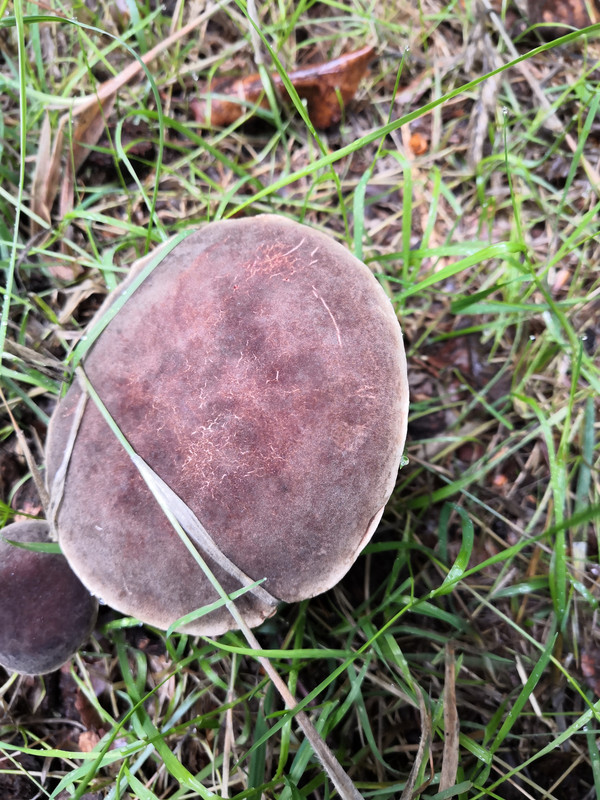
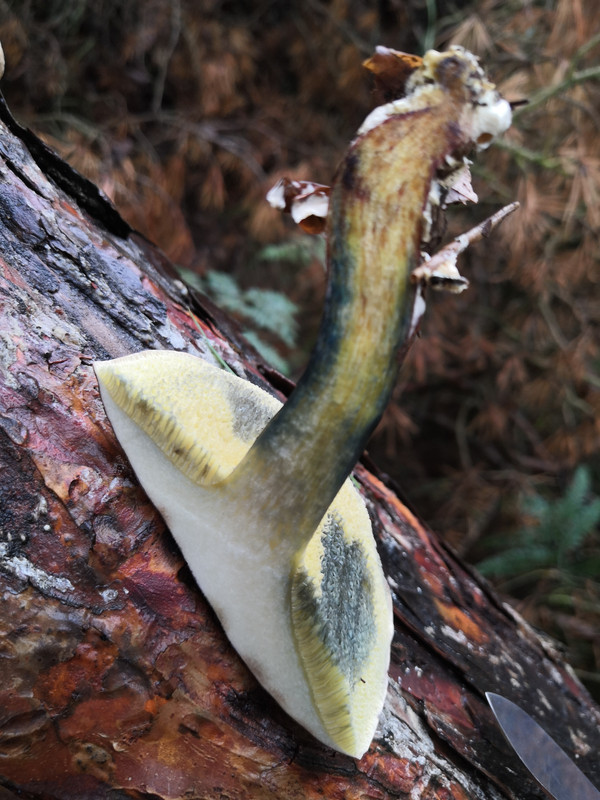
I looked up from the mushroom to find a muntac 10 or 15 metres from me and apparently oblivious. Or at least, unconcerned.
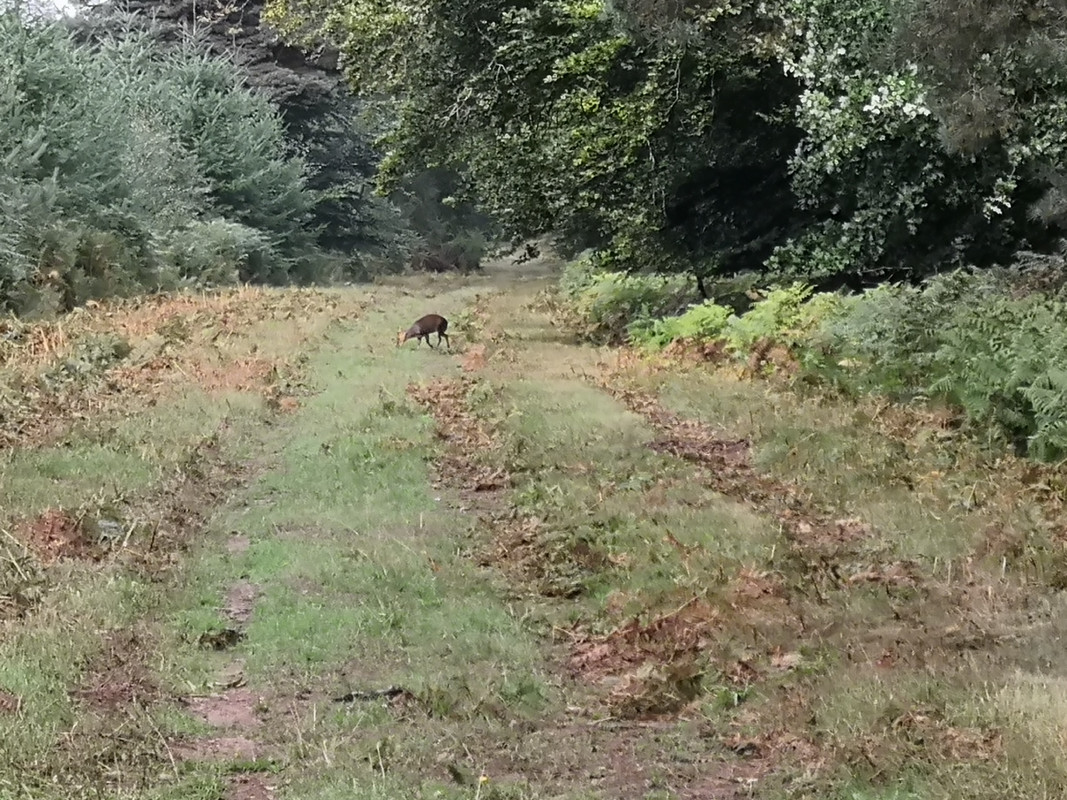
I continued and after a while came out onto open heath and meandered around for a while.
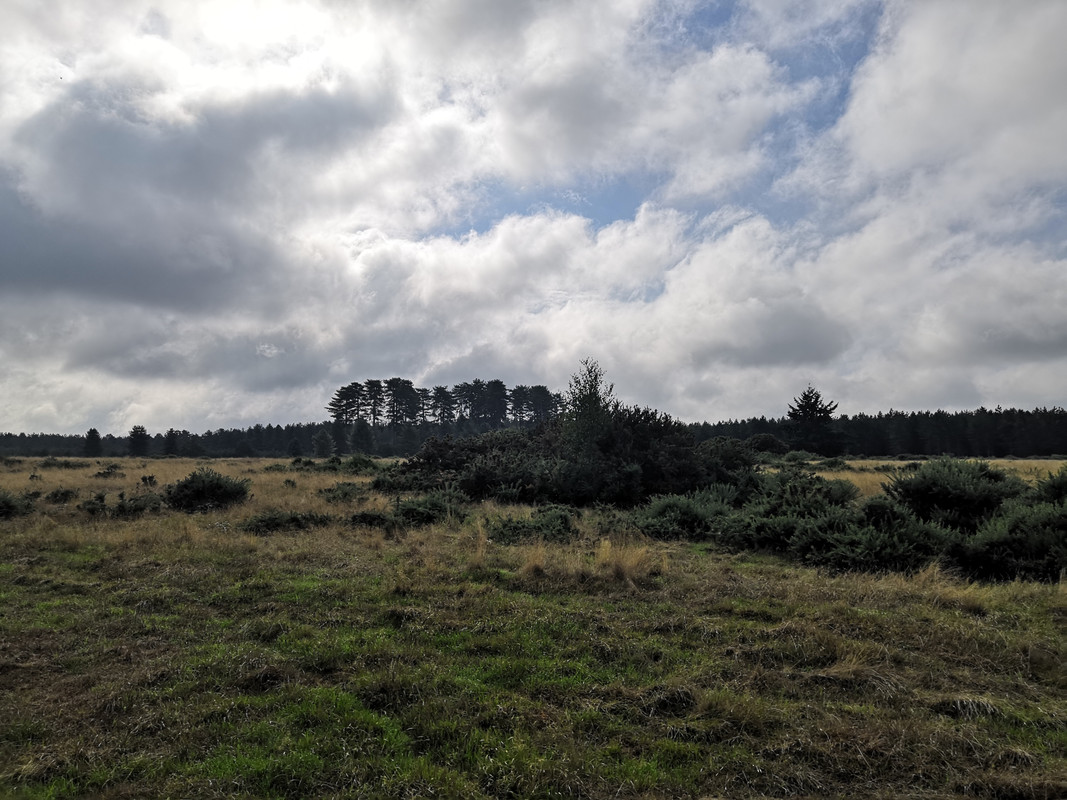
Time to practice some navigation. At this time of year, and it being near lunch time, I knew that the height of the sun from horizon, when pivoted to horizontal and increased just under 2-fold, would give me the point at which it rises in the morning. Being near enough equinox, this would give me east, give or take the odd degree. A quick check of the compass confirmed this. Had it been a month earlier I would have accounted for a 20 degree difference in sunrise position from east. July would have meant 35 degree difference, and at the solstice, a 40 degree difference. In the afternoon, the same technique finds west.
I retraced my steps in order to head into a different patch of forest, and immediately came across two parasols. How had I missed them moments earlier? They were both greater than 12 cm in diameter (differentiating them from other potentially toxic, smaller species), and with snake like markings on the stem (differentiating them from shaggy parasol). to browse the lepiotas in Roger Phillip's mushroom book is a little offputting. But these are big, so I can't confuse them with the deadly ones. I really can't.... right? In any case, these will be tomorrow's breakfast.
Half an hour later I found what I believe is a dryads saddle:

Although without black at the base of the stem, I have some doubts. I'd have also expected dryads saddle to feel a lot tougher, and to have more distinct scales on the surface. This one feels damp and a little soft. I'll give it a miss I think. Edit: I don't think it's dryads saddle. Edit edit: maybe it is after all.
Lunch was noodles among the pines. I used a new stove (msr pocket rocket 2), which seemed to boil water nearly instantly. It's a super stove, puts my others to shame really. By this point it was drizzling and human voices were echoing through the trees. There was something sinister about them, and wanting to be by myself, I moved on.
The afternoon found me in the vicinity of the river, and I was pleased to come across some false chanterelle. Tell tale signs were the slender, tapering stems and yellow or orange flesh when cut. Yet they smelt of apricot, which they're not meant to. Or is it my skin that smells of apricot? Who knows. I left them behind.
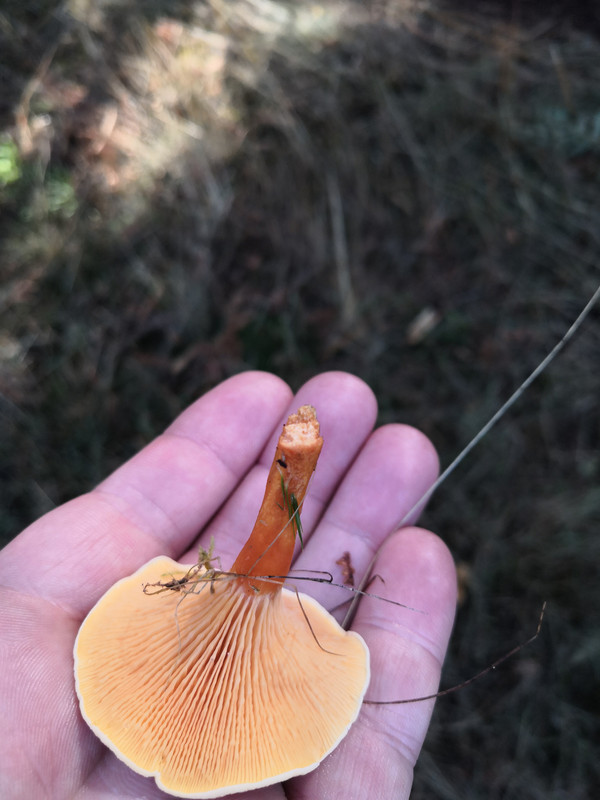
This was a much lusher area bordering a wetland, full of meadowsweet and worn out hogweed. The clouds cleared. By now I had walked a fair distance and was possitively hot.
I stumbled upon a bushcraft camp at the margin of the wetland. What a beautiful situation for a camp. A large fire scar harboured an empty can of northern monk (popular on all the bushcraft YouTube channels) among other detritus and broken glass. Someone had releived a Scots pine of the entirety of its bark up to head height, then gone at it with an axe in a haphazard manner. I dispaired and moved on through the wetland area and onto the river bank. This was chock full of hemlock water dropwort earlier in the summer, but none to be seen now. I paused to harvest some elderberries. Hops (humulus lupulus) were everywhere - I'm curious to know if anyone has made use of these, other than for flavouring beer?
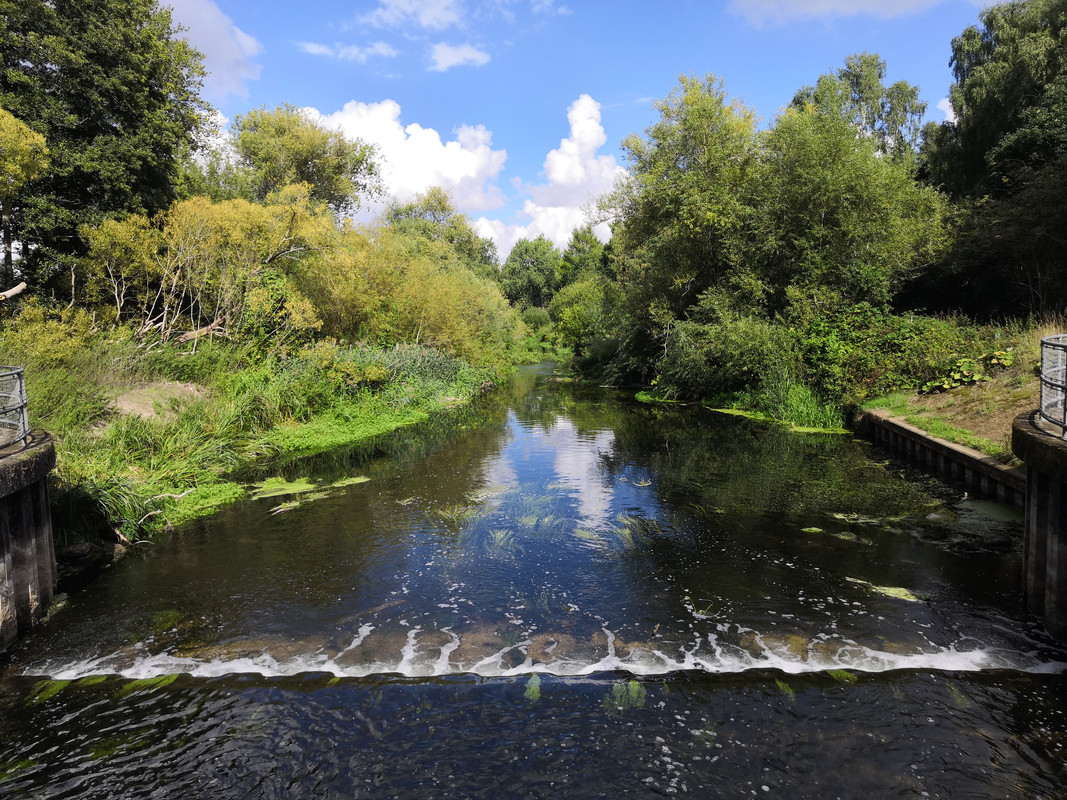
After following the river a while I headed back to the car and practiced my pacings on the way. I try to do this once a year as I find I forget my pace and stride length that I used when doing my chart, and it always takes me a couple of goes to get back into it. The other thing that frustrates me with pacings is my poor mental maths. My hope is when I next need to use it in the mountains, the required distances will be in simple multiples of ten. Otherwise I'll be in trouble.
Tldr; I got me some 'shrooms and had a good day.
The day started overcast and cool and had a particularly peaceful feel to it. I wandered through a mixture of Scots pine, larch, beech and oak. I was pleased to see plenty of acorns this year. Initially it seemed I was a little early for mushrooms, despite the recent rains.
But eventually I came across the following. It had pores on the underside - so some kind of bolette - and stained purple when cut. It had a malevolent look to it. Beyond that, I'm not sure what it is.


I looked up from the mushroom to find a muntac 10 or 15 metres from me and apparently oblivious. Or at least, unconcerned.

I continued and after a while came out onto open heath and meandered around for a while.

Time to practice some navigation. At this time of year, and it being near lunch time, I knew that the height of the sun from horizon, when pivoted to horizontal and increased just under 2-fold, would give me the point at which it rises in the morning. Being near enough equinox, this would give me east, give or take the odd degree. A quick check of the compass confirmed this. Had it been a month earlier I would have accounted for a 20 degree difference in sunrise position from east. July would have meant 35 degree difference, and at the solstice, a 40 degree difference. In the afternoon, the same technique finds west.
I retraced my steps in order to head into a different patch of forest, and immediately came across two parasols. How had I missed them moments earlier? They were both greater than 12 cm in diameter (differentiating them from other potentially toxic, smaller species), and with snake like markings on the stem (differentiating them from shaggy parasol). to browse the lepiotas in Roger Phillip's mushroom book is a little offputting. But these are big, so I can't confuse them with the deadly ones. I really can't.... right? In any case, these will be tomorrow's breakfast.
Half an hour later I found what I believe is a dryads saddle:

Although without black at the base of the stem, I have some doubts. I'd have also expected dryads saddle to feel a lot tougher, and to have more distinct scales on the surface. This one feels damp and a little soft. I'll give it a miss I think. Edit: I don't think it's dryads saddle. Edit edit: maybe it is after all.
Lunch was noodles among the pines. I used a new stove (msr pocket rocket 2), which seemed to boil water nearly instantly. It's a super stove, puts my others to shame really. By this point it was drizzling and human voices were echoing through the trees. There was something sinister about them, and wanting to be by myself, I moved on.
The afternoon found me in the vicinity of the river, and I was pleased to come across some false chanterelle. Tell tale signs were the slender, tapering stems and yellow or orange flesh when cut. Yet they smelt of apricot, which they're not meant to. Or is it my skin that smells of apricot? Who knows. I left them behind.

This was a much lusher area bordering a wetland, full of meadowsweet and worn out hogweed. The clouds cleared. By now I had walked a fair distance and was possitively hot.
I stumbled upon a bushcraft camp at the margin of the wetland. What a beautiful situation for a camp. A large fire scar harboured an empty can of northern monk (popular on all the bushcraft YouTube channels) among other detritus and broken glass. Someone had releived a Scots pine of the entirety of its bark up to head height, then gone at it with an axe in a haphazard manner. I dispaired and moved on through the wetland area and onto the river bank. This was chock full of hemlock water dropwort earlier in the summer, but none to be seen now. I paused to harvest some elderberries. Hops (humulus lupulus) were everywhere - I'm curious to know if anyone has made use of these, other than for flavouring beer?

After following the river a while I headed back to the car and practiced my pacings on the way. I try to do this once a year as I find I forget my pace and stride length that I used when doing my chart, and it always takes me a couple of goes to get back into it. The other thing that frustrates me with pacings is my poor mental maths. My hope is when I next need to use it in the mountains, the required distances will be in simple multiples of ten. Otherwise I'll be in trouble.
Tldr; I got me some 'shrooms and had a good day.
